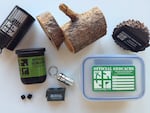On May 2, 2000, the U.S. government lifted restrictions on GPS, making it more accurate and useful for the general public.
That day is now known as Blue Switch Day and while these lifted restrictions allowed us to have more accurate mapping from place to place, what the government was not expecting was the birth of a new hobby with Oregon origins: geocaching.

Geocache containers can come in various shapes and sizes. Across the world there are roughly 3.3 million caches hidden.
Courtesy of Groundspeak
Geocaching is an outdoor activity where participants hide containers, known as caches, and upload the coordinates to a website for others to hunt down. It’s akin to a treasure hunt, but using GPS coordinates to find hidden objects within a square radius of about 16 feet. Nowadays, most geocaching is done with the aid of a smartphone, but in the early days, enthusiasts used handheld GPS devices.
PJ Hubbard is the treasurer of GEOregon, a nonprofit organization that supports and helps grow a community of new and experienced geocachers in the state. Hubbard himself has found more than 9,000 caches since he was first introduced to it by his husband seven years ago. He says what makes the hobby so special is how hidden, yet out in the open, caches are.
“Ninety-nine percent of you have walked past a geocache today. You just didn’t know it,” Hubbard said.
Caches are ranked by difficulty on a scale from 1 to 5. As participants search for the cache using GPS, it’s finding the hiding spot that is the real challenge.
“Geocachers are devious people. We will take something that you see in plain sight and make that a geocache,” Hubbard said. “In Buffalo, New York, there was a geocache hidden in an old toilet that was discarded in the middle of the woods, and they turned the cistern in the back into a geocache.”

GEOregon members at our "CITO" (Cache In Trash Out) event we held on April 12th, 2025 along a 1.2 miles stretch of Sunnyside Road as a participant in the Clackamas County Adopt-A-Road program.
Courtesy of Kinley Baker
There are more than 3.3 million caches around the world today, but the first ever cache was hidden by Dave Ulmer just outside of Estacada, Oregon at Beaver Creek, on May 3, 2000. Ulmer, whom many regard as the father of geocaching, wanted to test the accuracy of GPS coordinates and decided to hide a large bucket in the woods that contained various items such as a videotape, slingshot and a book.
For Hubbard, the location holds a special place for him and is one of his favorite caches.
“So, once we moved here from Buffalo, New York, that was one of the first things that we had to go to, and [it] ranks among our most memorable geocaches that we’ve logged.”
To celebrate the hobby’s 25th anniversary, GEOregon is hosting a Block Party on September 13, 2025 at Champoeg State Park.
PJ Hubbard spoke to “Think Out Loud” host Dave Miller. You can listen to the full conversation here:
